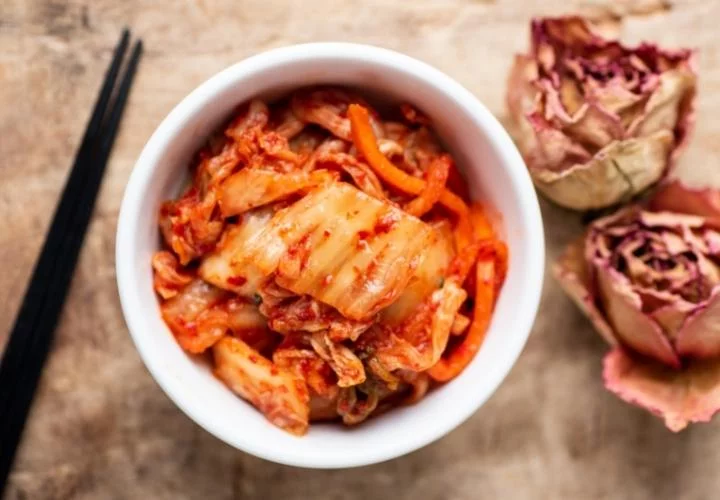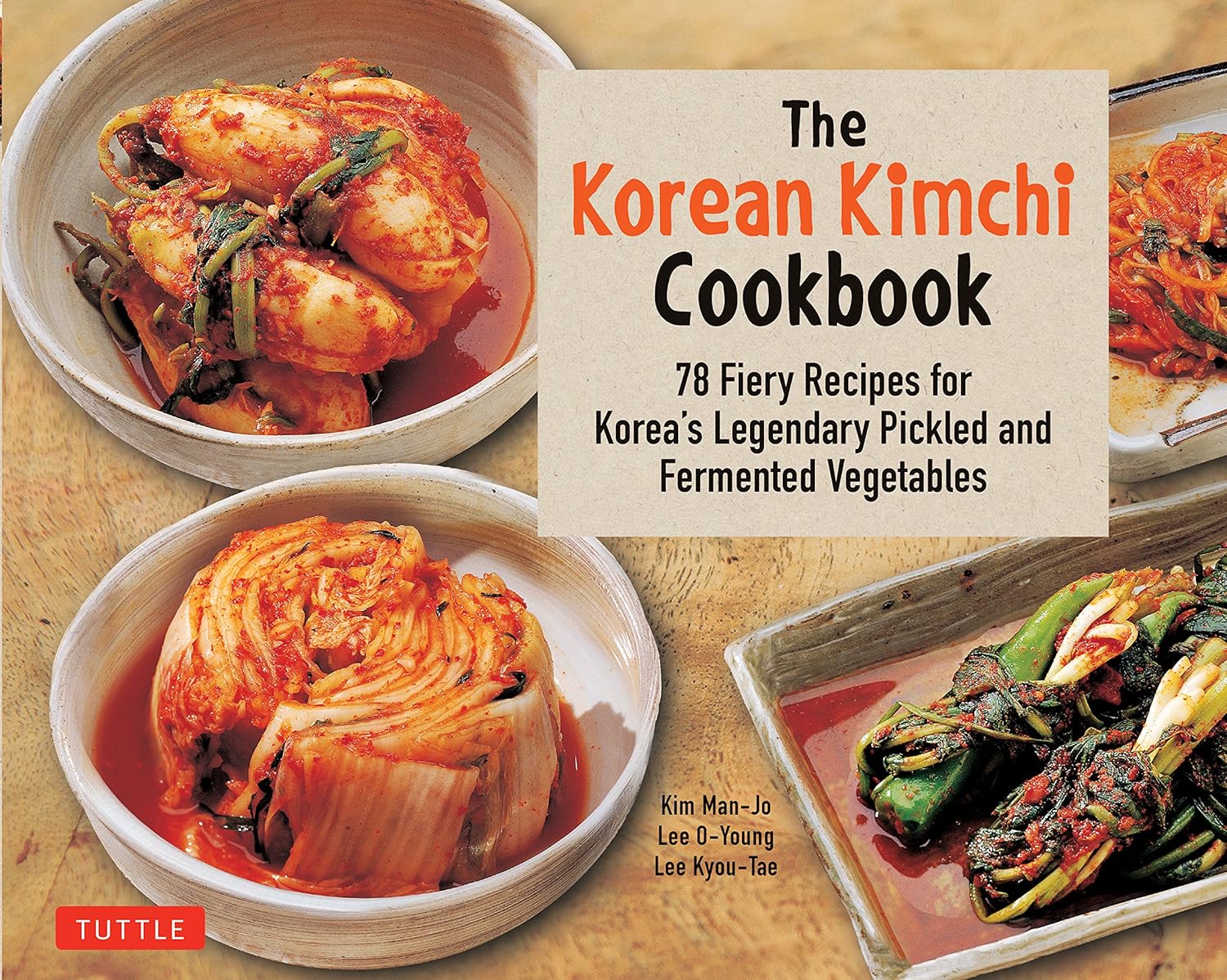Finally, it’s time for a homemade Korean Kimchi Recipe. My grandma makes the best kimchi and I can vouch for that. This kimchi is the real deal. It is authentic, delicious, and classic. Kimchi is a great side dish for any meal. It also makes some of the most delicious Kimchi creamy dip, Kimchi Fried Rice, Spicy Kimchi Tofu Stew, and Kimchi Pancakes.
This recipe is a treasured one that I will always keep. This Grandma’s Classic Kimchi recipe is one of my most treasured. It was an honor to learn from her and, best of all, it tastes damn good. It is my pleasure to share this traditional Korean Kimchi recipe with all of you!
Kimchi, also known as kimchee, is a traditional Korean dish that’s made with fermented and salted Napa cabbage. Marinated and fermented vegetables are used to preserve them during winter. Although Napa cabbage is the most popular vegetable used to make kimchi carrots, radishes and cucumbers are also used.
There are many kimchi recipes, which vary according to the season and region they were made in. It is easy to make vegan kimchi, you just need to keep plant-based ingredients.
Kimchi is readily available and affordable, but I would always advise you to make your own homemade kimchi. Although it can take some time to prepare the vegetables, unlike other fermented foods like bread, beer and kombucha, it is mostly an easy process. Kimchi can be kept in the refrigerator for quite some time, making it a versatile, economical and simple-to-prepare dish.
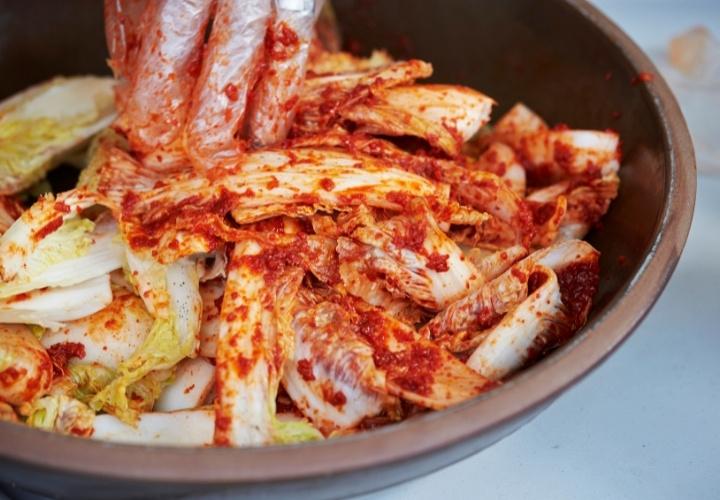
How is Korean kimchi made?
Korean kimchi is made by fermenting napa cabbage or radishes with a mixture of salt, garlic, ginger, chili pepper, and fish sauce. The vegetables are soaked in salt water, seasoned, and then stored to ferment over time.
What is the best kimchi in Korea?
The best kimchi in Korea is often considered to be homemade, using traditional recipes passed down through generations. However, regions like Jeonju and Gwangju are known for their high-quality kimchi, with Jeonju’s Baek (white) kimchi being a popular choice.
What is the common kimchi in Korea?
The most common type of kimchi in Korea is napa cabbage kimchi, also known as “baechu kimchi.” It’s the standard version found in most households and restaurants.
What is kimchi sauce made of?
Kimchi sauce is typically made from red chili powder, garlic, ginger, fish sauce, and sometimes sugar. The mixture is used to coat the vegetables during the kimchi-making process.
Is kimchi healthy?
How does Kimchi taste?
Kimchi has a very unique taste which makes people love it or hate it, this is mostly due to some people don’t like sourness. Kimchi’s taste is complex and can vary depending on the recipe. Kimchi will have three main flavors: umami, spicy, and sour. The vegetables you use, the fermentation time, and the amount of sugar or salt used will all affect the taste.
Kimchi is a fermented food, so its predominant flavor is usually sour. The bacteria that produces lactic acid during fermentation gives kimchi a spicy, spicy flavor similar to sauerkraut. If garlic is used in kimchi, the flavor intensifies during fermentation. Kimchi can be spicy depending on the amount of pepper used and the type of pepper.
What do I love about kimchi/kimchee?
Besides being one of the healthier food, kimchi has definitely got something addictive regarding its flavor. There are many wonderful flavors. It has three distinctive flavors: garlic, sour, and spicy. Also, kimchi has a certain level of crispiness which adds to the fullness of experience while eating.
Is homemade Kimchi really spicy?
It all depends on what type of kimchee is made and/or bought. You can make your own kimchI, which is less spicy than some.
Why is homemade kimchi more delicious than store-bought?
As I’ve said before, this kimchi recipe will amaze your taste buds. And as you know, most homemade recipes are better than store-bought, in some cases even better than in restaurants.
Some other reasons why is homemade kimchi version better:
- Homemade kimchi is much cheaper
- With some tweaks, you can make it your own recipe
- Share with family and friends
- It’s fun!
Can American cabbage be used as a substitute?
I wouldn’t advise, it won’t be the exact same. Napa cabbage has different properties, it is more crunchy and overall makes way better kimchi.
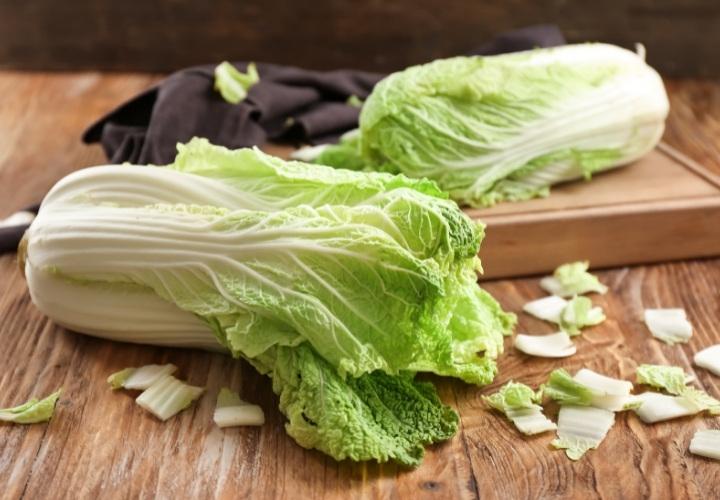
Can I substitute red pepper powder with gochujang?
No, don’t do that! Although gochujang is a red chili paste, you shouldn’t substitute it with red pepper, because the texture is totally different.
For how long should kimchi be fermented?
Kimchi is fermented for at least one day. Usually, Kimchi is fermented from 1-3 days at room temperature or 21 days in the fridge, depending on how sour you want your Kimchi to be.
After opening your kimchi jar, it can stay fresh for up to a week at room temperature, and for up to 6 months refrigerated. While refrigerated your kimchi keeps the fermentation process, but if you don’t like your Kimchi to sour, you can use it for up to 3 months.
If Kimchi becomes too sour, but you don’t want to throw it away, try mixing it into some dishes with a milder flavor, like rice.
Can regular salt be used for Kimchi?
My grandma explained to me that thick sea salt is better than salts like Morton and Diamond kosher salt. It makes cabbage soft and withers and also removes too much moisture.
Look out for coarse sea salt grains.
What if I don’t have red pepper powder for Kimchi?
Okay, I have a small discomfort because everyone wants authentic cultural dishes, but not everyone is willing to pay for the authentic ingredients. 🙂
This red pepper powder cannot be replaced with any other. This powder is the only powder if you want to make kimchi authentic.
It is not the same as cayenne pepper. It is not the same as chili powder. It is not the same as red bell pepper flakes. It is not the same as powdered pepper flakes. It is not the same as Sriracha.
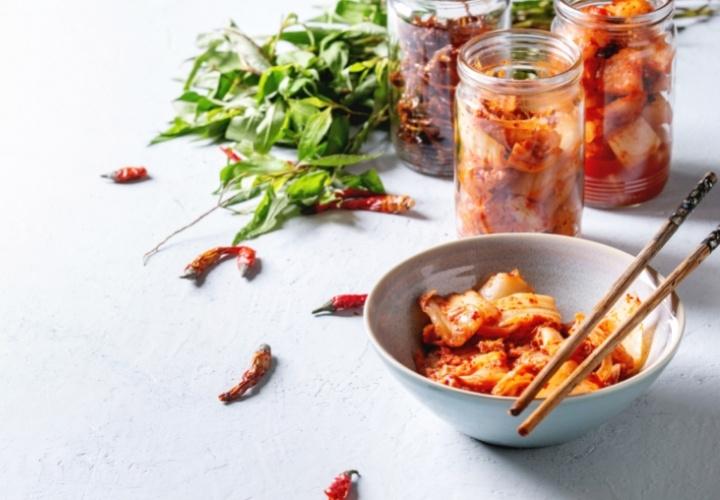
How to make Kimchi Taste better?
It should be left out for a longer time before it is put in the refrigerator.
Is there a way to make homemade kimchi less sour?
Place it in the refrigerator within 12-24 hours. After this, let it rest for at least one night and then place it back in the refrigerator the next morning.
What type of jar should I use for Kimchi?
I purchased half-gallon wide-mouthed jars. It is very simple to place kimchi into jars with wide mouths.
Homemade Kimchi Recipe
Ok, now that we know everything we need to know on how to make authentic Kimchi recipe it is time. Kimchi/kimchee is a favorite of mine, so I recommend making homemade kimchi. It’s cheaper to make at home than to buy it in the grocery store.
If you like this Authentic Korean Kimchi Recipe, share it with your friends and to your Pinterest board!
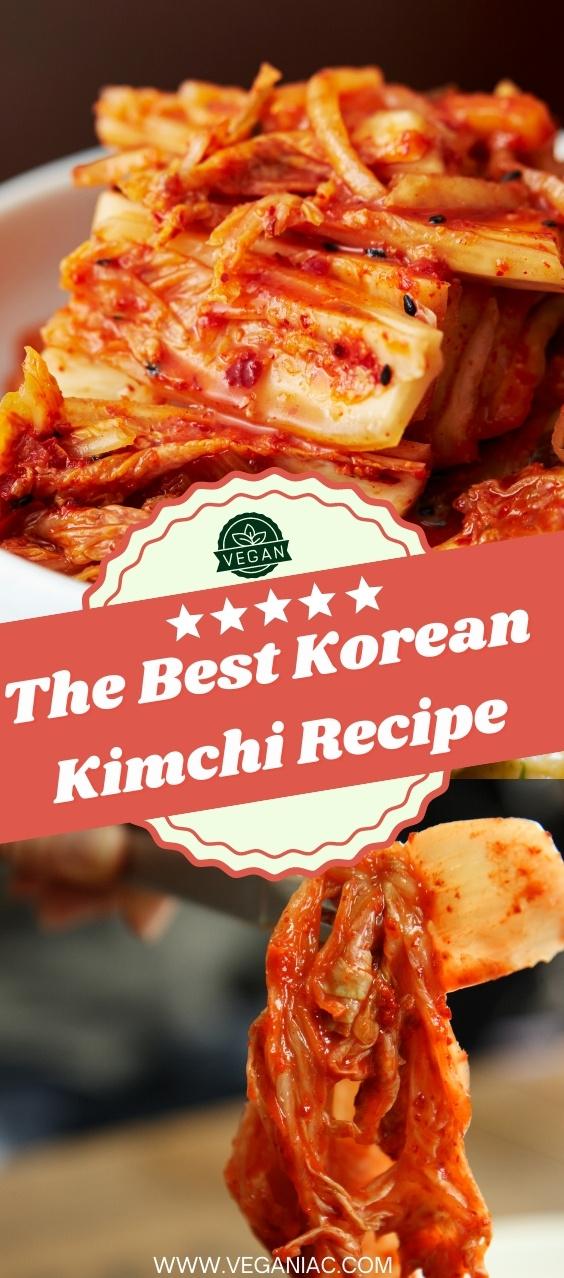
Ingredients
For the cabbage:
- 16 Oz Napa cabbage (cut into 1 inch size)
- ½ cup of sea salt
- 1 cup of water
Seasonings for Kimchi:
- ½ medium sweet onion, finely chopped
- ½ teaspoon sugar
- 1 bulb garlic, peeled and minced
- ¼ cup water
- ½ cup red pepper powder
- 1 bundle green onions, julienned
Directions
- Cut the cabbage into 1-inch size pieces. Mix and Stir the Napa cabbage with the already prepared mixture of sea salt and water using a large bowl, until the sea salt has completely dissolved. Mix the cabbage using your hands. Allow it to stand for around 2 hours.
- Using a blender, mix the garlic and onion with 1/4 cup of water until you have a smooth paste. Combine the mixture in a large bowl. Add the red pepper powder, green onions, salt and sugar. To make a separate radish-kimchi separate the portion for radish kimchi.
- When the cabbage is ready, rinse nicely it to get rid of most excess salt. Toss it with the red pepper seasoning mix until the cabbage is well coated.
- The seasoned kimchi should be placed in a large jar (large-mouthed jar). With your fist, press the cabbage to compress the contents nicely. Continue filling the jar with the seasoned kimchi. If necessary, you can use another jar.
- Cover the pallet jars with a tight fitting lid and let them rest outside overnight at room temperature. The next day, taste the kimchi. If you like it more sour leave it out for another day or two. When the kimchi is according to your liking, you can place it in the fridge.
- Kimchi is a fermented food that can be kept in the refrigerator for a very long time. But I wouldn’t say it lasts more than 6 months.
Vegan Kimchi Recipe
Vegan Korean kimchi is a plant-based version of the classic dish, using simple ingredients for a bold, tangy flavor. Here’s how you can make it yourself:
Ingredients:
- 1 medium napa cabbage
- 1/4 cup salt
- 2 tablespoons Korean chili flakes (gochugaru)
- 1 tablespoon sugar
- 2 cloves garlic (minced)
- 1 inch ginger (grated)
- 2 tablespoons soy sauce or tamari (vegan substitute for fish sauce)
- 4 green onions (chopped)
- 1 carrot (julienned)
Procedure:
- Prepare the cabbage: Cut the napa cabbage into quarters, remove the core, and chop into bite-sized pieces. Rinse and toss with salt, letting it sit for 1-2 hours to soften. Rinse thoroughly and drain.
- Make the paste: Mix chili flakes, sugar, garlic, ginger, and soy sauce/tamari in a bowl to form a paste.
- Combine: Add the green onions, carrot, and cabbage to the paste, mixing thoroughly so everything is coated.
- Ferment: Pack the kimchi into a jar, pressing it down to remove air pockets. Leave some space at the top, close the jar, and let it ferment at room temperature for 1-2 days.
- Store: Once fermented to your taste, refrigerate and enjoy your vegan kimchi!
Famous Cookbooks for Korean Kimchi
If you’re a beginner struggling to create kimchi at home, these two Korean cookbooks are perfect for guiding you through the process. Whether you’re aiming for a traditional or modern twist on kimchi, the following books will help you master the art of making it with confidence:
- “Maangchi’s Real Korean Cooking” by Maangchi – This popular cookbook offers traditional Korean recipes, including a detailed guide on making kimchi, from basic napa cabbage kimchi to more complex variations like radish and cucumber kimchi. Maangchi breaks down the steps clearly, making it accessible for beginners.
- “Korean Home Cooking” by Sohui Kim – This cookbook provides a variety of authentic Korean recipes, with a special focus on kimchi and its importance in Korean culture. It includes recipes for different types of kimchi, along with helpful tips on fermentation and ingredient selection, making it perfect for home cooks who want to try authentic kimchi.
- “The Kimchi Chronicles” by Marja Vongerichten – This book delves into Korean cooking, offering a range of kimchi recipes alongside explanations of its cultural importance. Marja combines traditional methods with personal stories, making it both educational and engaging for home cooks.
Best Kimchi Recipe Cookbooks
The Kimchi Cookbook: 60 Traditional and Modern Ways to Make and Eat Kimchi
Why it’s the best: This cookbook by Lauryn Chun offers a mix of traditional and modern kimchi recipes, making it perfect for anyone looking to explore the diverse world of kimchi. With 60 easy-to-follow recipes, it’s ideal for beginners and experienced cooks alike. Its wide range of flavors—from classic napa cabbage to unique fusion styles—has made it a top seller on Amazon Australia, cementing its reputation as a staple in any home cook’s collection.
- Price: Around AUD $30
- Copies Sold: Over 100,000 copies sold globally.
- Buy here at Amazon
The Kimchi Chronicles: Korean Cooking for an American Kitchen: A CookBook
Why it’s the best: This cookbook bridges the gap between traditional Korean flavors and the American kitchen. Written by Marja Vongerichten, it presents accessible kimchi recipes that cater to Western palates while staying true to authentic Korean methods. The Kimchi Chronicles also includes non-kimchi dishes, making it a well-rounded addition for anyone looking to delve into Korean cuisine. It has consistently been a favorite due to its relatable approach and creative recipes.
- Price: Around AUD $35
- Copies Sold: More than 50,000 copies sold worldwide.
- Buy here at Amazon
The Korean Kimchi Cookbook: 78 Fiery Recipes for Korea’s Legendary Pickled and Fermented Vegetables
Why it’s the best: Featuring 78 bold and spicy recipes, this cookbook dives deep into the heart of kimchi-making. Authored by Korean chefs, it provides a comprehensive guide for anyone who wants to master the art of fermentation. The clear instructions, along with mouthwatering photographs, have made it a go-to resource for kimchi enthusiasts, driving high sales and positive reviews across the globe.
- Price: Around AUD $40
- Copies Sold: Over 75,000 copies sold.
- Buy here at Amazon

